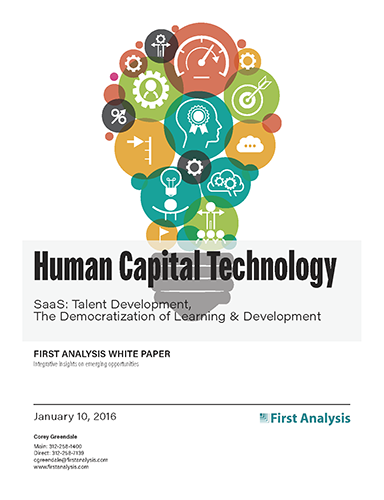White paper: Human capital technology
SaaS: Talent development – the democratization of learning & development

The world of talent development is undergoing substantial change, as a number of factors drive learning and development (L&D) up the strategic priority list for employers of all sizes. Shortages of qualified workers in high-demand fields such as technology, sales, and marketing are making it difficult for companies to meet their human capital needs solely by recruiting new talent, and the accelerating pace of change in the knowledge economy means workers need to be continually upgrading their skills sets in order to keep their employers and themselves competitive. Demographics are likely to intensify the need for continuous learning and development, with the Bureau of Labor Statistics projecting U.S. workers aged 16 to 24 will shrink 13.1% in the decade ending 2024, driving greater need to develop talent internally.
With this backdrop, the C-suite is increasingly aware that talent will be a key competitive differentiator over the coming years and that legacy learning and development structures and processes may not be sufficient to address the looming challenges. Moreover, as the need for continual upskilling intensifies, the ways employees develop their capabilities are evolving and multiplying, with low-cost, platform-agnostic learning technologies making it possible for workers to take their professional development—previously the purview of colleges and HR departments—into their own hands.
We believe these and a number of other factors are driving strong growth opportunities for providers of technologies that make talent development more accessible, more effective, and more efficient. Historically, workers received general and professional education in college and job-specific and compliance training inside the organization: two entirely discrete processes, both of which were distinct from the employee’s day-to-day job. Now, enabled by the technologies discussed in this report, learning & development is an increasingly important link in the broader human capital value chain, helping drive engagement, build culture, and enable innovation.
While technology as a catalyst of workforce effectiveness is not a new phenomenon, the benefit has come predominantly in the form of automation-driven efficiency. We expect cutting-edge technologies to drive considerably more value in human capital in the future, spurring revenue growth by ensuring employers have the educated talent they need to meet strategic goals and that the talent continually develops and is provided growth opportunities that maximize value for both employee and employer. At the same time, we expect innovative human capital technologies to drive cost efficiencies by reducing expenses associated with inefficient and ineffective talent development. In short, we believe we’ve only scratched the surface of the enormous value that employers will ultimately derive from new talent development technologies and that providers of these high-impact technologies are well-positioned for strong growth as key weapons in the competitive knowledge economy.
TABLE OF CONTENTS
Includes profiles of 61 public and private companies
- Industry drivers
- Learning management systems (LMS)
- Learning content management system (LCMS) providers
- Online video-based learning content providers
- MOOCs
- Disruptive career preparation platforms
- Learning assessment and analytics
- Social and gamified learning
Technology allows learning to be an integral component of workflow
Historically, learning has been a disjointed process throughout a professional’s work life. In the U.S., a typical worker likely participated in formal education as a more or less full-time job through high school, and potentially through college or graduate school, then entered the workforce. At that point, the vast majority of the knowledge gained through formal schooling probably became irrelevant, as the worker needed to learn an entirely different set of skills and information for his or her job. Many roles require job-specific training, certifications, or professional development for which the worker generally prepared with a process that took a form similar to formal education: one or more days away from his or her job, in a physical classroom, with instructor-taught information often forgotten soon thereafter. This is a generally inefficient process as well as an ineffective one in a rapidly evolving world in which learning needs to be continuous rather than a compliance-driven side project to be completed annually.
From the perspective of employees, technology allows access to exactly the information they need at exactly the time they need it and in a manner that is both convenient and highly effective. From the employer’s perspective, the same technologies allow the measurement of workers’ skillsets, informing workforce development and succession decisions and driving cost-savings in the form of more efficient learning processes.

Request full report
To access the full report, please provide your contact information in the form below. Thank you for your interest in First Analysis research.
